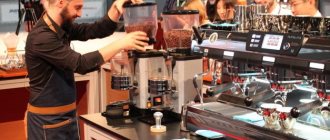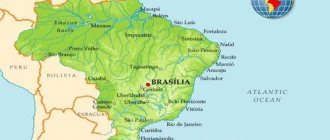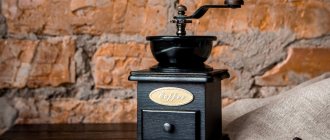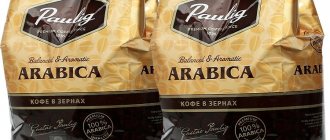The history of the barista profession
Initially, the barista profession originated in Italy. However, it became famous thanks to Howard Schultz, the founder of Starbucks, who visited Italy in 1980 and was delighted with the beauty of making coffee. He filmed all the elements of preparing and serving the drink and showed it in America, thereby the coffee shop soon began to flourish and generate even more income.
A barista and the owner of an establishment rolled into one is a common occurrence.
In Europe, baristas are men aged 30 years and above, since in the West this activity brings quite high profits. Also, the fact is that a barista in Europe is not a job, but a vocation. Basically, a barista in Europe is both the owner of a cafe and a waiter and cleaner. In Russia, baristas are mostly girls aged 18-23 years old.
Today in Italy there are even family clans that grow coffee beans themselves, prepare and roast them with their own hands, and know a huge number of variations in preparing coffee drinks.
Aeroexpress and other drinks
Among baristas, drinking coffee with sugar is considered the biggest crime. You can still forgive the milk, especially since we use low-lactose farm milk, which is not so harmful and is also sweeter than usual. When a visitor orders raf coffee, which is made with heavy cream, it immediately becomes clear to us that he does not understand coffee. Lattes are also considered rustic, as they contain a lot of milk and little espresso. But even if someone orders a Hario or a Chemex, this is not a guarantee that this guest understands coffee. I have had cases when I brewed coffee through a funnel for quite a long time, tried, and the person simply added sugar and cinnamon to it. Once we ran out of filters, and instead of a Chemex, we poured the client plain freshly brewed coffee. It was a shame, but the guest didn’t notice the difference, he liked everything.
We do not impose our point of view on anyone, we can only recommend taking something else. But sometimes visitors have problems not so much with the choice of drinks, but with their names. Coffee is always masculine for me, no matter what the Ministry of Education says. The word "latte" has the stress on the first syllable, just like the word "chemex". We are already accustomed to “expresso”, but once they ordered “aeroexpress” from me instead of an aeropress.
What should this specialist do?
The main thing in the work of a barista is working with visitors. It is important not only to be able to make coffee, but also to do it beautifully and charge the client for a positive day. The barista must know how the coffee beans were prepared, where they came from, how they were prepared, how and how long to store the coffee beans, etc.
A professional should understand what coffee grind is needed to prepare different variations of coffee. And of course, the most important task of a barista is the exclusive mastery of a coffee machine, be it a regular coffee maker or professional equipment for making coffee.
A professional barista knows how to create any pattern on the surface of coffee
One of the excellent professional qualities of a real barista is mastery of the art of latte art. When drinks with an espresso base are painted with beautiful designs of milk or cream on the foam. Thus, a real barista must not only be a specialist in making coffee, but also a good psychologist, showman and designer.
What should a barista be able to do?
- Prepare about 40 varieties of coffee;
- Know all the intricacies of making coffee;
- Be able to determine the degree of roasting of coffee by smell;
- Distinguish between coffee varieties and the origin of the beans;
- Be able to make drawings on coffee foam, that is, master the art of latte art, etc.
The barista knows the secrets of making all types of coffee
Barista: features of specialization
The name of the profession comes from the Italian word barista, which translates as “a person who works behind a bar.”
The employee’s responsibilities include preparing espresso in compliance with technological rules and taking into account the subtleties of the process at all stages - from the purchase of coffee beans to decoration and creative presentation.
Key Responsibilities
The main tasks of a barista are to prepare drinks in a coffee machine and serve them to customers of the establishment. The specialist's responsibilities include:
- Preparation of drinks. The master needs to know 40 classic recipes, be able to select the proportions of ingredients, determine the degree of grinding and roasting of coffee beans, calculate the water temperature and the time of the extraction process to obtain a rich taste.
- Communication with customers. At the request of a coffee shop visitor, the master is required to tell about the types and brands of beans, explain the intricacies of preparation, and help make a choice. The specialist’s responsibilities include supporting casual conversation and creating a cozy, relaxing atmosphere in the establishment.
- Working with technology. A barista must be able to handle equipment: a coffee machine, coffee grinder, holder, pitcher. The specialist’s responsibilities include cleaning equipment and troubleshooting.
- Carrying out inventory. The employee controls the quantity of remaining products, draws up a purchasing plan, and monitors compliance with the rules for storing ingredients.
- Working with the cash register. The specialist independently carries out settlements with the client.
The barista prepares drinks, interacts with customers and operates the cash register.
The full list of employee responsibilities depends on the characteristics of the establishment. In some coffee shops, the barista additionally prepares tea or dishes according to simple recipes, and acts as a waiter or cleaner.
Experienced craftsmen are often trusted to independently select suppliers of coffee beans and monitor the process of collection, roasting, and grinding.
Qualities, knowledge and skills
To perform his duties, a specialist must:
- be able to operate a coffee machine, holder, pitcher, grinder and other equipment, including correctly selecting the settings for brewing drinks with a rich taste;
- be sociable, non-conflict, maintain a cheerful mood in a coffee shop;
- know the characteristics of varieties, types, brands of coffee, the history of their origin, where the beans grow, differences in taste, subtleties of brewing and extraction;
- be able to froth milk;
- know the basics of client psychology;
- understand the intricacies of recipes, be able to correctly select the proportions of espresso, cream, syrup and other additives to obtain a rich taste;
- know coffee etiquette, including the rules of creative presentation;
- be able to determine the quality of the finished product, focusing on sight, smell, taste and aftertaste;
- have imagination and creative abilities to design a drink;
- know the intricacies and rules of roasting, grinding, storing grains;
- master the creative skills of latte art - drawing on coffee foam with chocolate, cinnamon or milk;
- be able to determine the required water temperature, extraction time, force of compaction of the coffee beans and other parameters for preparing espresso with the desired taste.
To perform your duties, you must be able to operate a coffee machine well and be sociable.
A good coffee maker constantly improves his skills: he studies the intricacies of recipes, reads specialized literature, and develops creative techniques based on personal experience. In the barista profession, the desire of the master to grow and develop is valued.
Differences from a bartender
Representatives of both professions work behind the bar. The main difference between the two is that a bartender specializes in alcoholic drinks, while a barista specializes in brewing espresso. Detailed comparison table:
| Profession | Specialization | Knowledge level | Ingredient Units | Beverage temperature |
| Barista | Espresso and other bean-based drinks | Deep: understanding the intricacies of coffee culture and history is no less important for a master than having practical and creative skills | Grams, milliliters | High |
| Bartender | Alcohol, mainly cocktails | Superficial: practical skills and the taste of ready-made cocktails are valued | Ounces, parts | Low |
In some establishments, 1 employee performs both functions. This practice is common in bars in Italy and other European countries.
average salary
The average salary of a barista in the Russian Federation is 30,000 rubles. The maximum salary is received in Moscow and the Moscow region, as well as in the Kamchatka Territory. Their salary is about 35,000 rubles. The minimum salary in St. Petersburg is 26,000 rubles per month.
In Kazakhstan, the average salary of a barista is 23,000 rubles. The fact is that there are no professional courses for baristas in the country, so new ones have to be trained by specialists in master classes or sent for an internship abroad.
Baristas are usually paid hourly
In the United States of America, the average salary is 900 rubles per hour. Thus, the average salary of a barista in the USA is 175,000 rubles per month. In America, the work of a barista is valued much more than in Russia and the CIS countries.
In Italy, the work of a barista when preparing regular espresso is estimated at 1,200 rubles per hour. In addition, every coffee shop has a tip box, where Italians leave fairly good tips.
What keeps you going as a barista?
- Well, definitely not money. We don’t have a fixed salary, so I don’t know until the very end what will be on my card at the end of the month.
I have always believed that the work itself is more important than profit. That is why I am here now, and not selling windows in villages. I like to communicate with guests, because each person is a little story that can sometimes amaze you to the core.
I like to “play” with coffee, invent my own drinks, learn more information that is related to my business. Yes, there are a lot of rocks here that are easy to break on.
In a team, you can run into trouble, and your work will often be underestimated, and there are also a lot of guys who constantly want to teach you how to make coffee “in their own way.” You don’t always know everything, it’s awkward to disturb someone, but it’s necessary. But the process itself is simply wonderful.
I want to make coffee, I want to see my colleagues every day, I want to come to the outlets and spend my time there, meeting dozens of new faces. That's what's holding me back, I guess.
How to learn to brew coffee?
Anyone can become a professional barista; you just need to have the desire to work in this field. There are four ways to learn skills: on your own, on-the-job training, in courses, and at universities.
You can sign up for barista courses
You can learn on your own by reading various literature about making coffee, watching videos and attending various master classes. In addition to the theoretical part, you need to have a large number of hours of practice. The more practice, the higher the skill.
One of the best ways to learn the art of making coffee is to find an open position at a coffee shop. Typically, professional coffee shops will be happy to train people who are ready to work as baristas for free. One of the main qualities when applying for a job is a pleasant appearance, knowledge of several languages, friendliness and sociability.
It is more effective to immediately get a job as an intern in a cafe
There are also special courses where you can learn to be a professional coffee connoisseur, master the art of making coffee and coffee drinks, and also learn a way to design espresso called latte art. Such courses are quite expensive, since basically everything is carried out in practice using special professional equipment.
There are also special schools and universities for future baristas. Basically, the training will be useful individually and no longer for ordinary workers behind the bar, but for future owners of the company, who must understand all the intricacies of making coffee, as well as finding the necessary equipment and ingredients for a future coffee shop.
Individual training allows you to learn the basics of the profession in record time
Coffee extraction
Extraction is the process of extracting substances from ground beans during the brewing process. The finished taste and aroma of coffee depends on its quality and duration. Estimated extraction time:
- for coarse grains - 6-8 minutes;
- medium - 4-6 minutes;
- thin - 1-4 minutes.
The barista controls the time to achieve a rich, balanced taste.
Newcomers to the profession are guided by the standards that are prescribed in professional literature. But over time, they begin to calculate the process time intuitively, relying on their own skills. This is considered one of the creative aspects of specialization.
Equipment used by a barista in a cafe
The quality of equipment in a coffee shop shows what quality of coffee will be offered to the visitor. Thus, you need to choose the highest quality equipment to ensure that customers return to the coffee shop again and again. The main equipment is a professional coffee machine, in which various coffee preparation functions will be available.
One of the main tools for a barista is a coffee grinder with a dosage for direct extraction into a horn. Thus, all the taste and smell from the beans will be transferred to fresh coffee, where the smell of future coffee will not evaporate and the taste will be even richer.
It is imperative to use fresh, purified water for making coffee, so it is better to keep the filter close to the coffee maker for convenience.
A tamper is a special tool for pressing and compacting ground grains in a holder. They must be made of metal so that the taste of the prepared coffee is exquisite and does not change its taste when in contact with other elements. Usually the tamper is stored next to the coffee maker, as it is constantly needed for use. And usually a special mat is used to press the coffee in the holder so as not to scratch the tools.
A pitcher is a special container with a spout for frothing milk, which is subsequently poured into coffee or used to prepare drawings on coffee using latte art.
To create drawings on coffee, you will need a pitcher
Be sure to use dry wipes to wipe down all the tools used to make coffee after each use. And constantly clear your work area of coffee and milk that accidentally gets on the table.
Rules for making coffee: nuances of work
A barista must be able to brew drinks using a coffee machine. The process consists of:
- Holder preparation. The employee wipes, cleans, dries it, and then warms it up to operating temperature.
- Dosages. The worker fills the holder completely, with a slide. In luxury coffee shops, the specialist uses freshly ground beans from a coffee grinder; in standard coffee shops, an automatic dispenser is used.
- Distributions. The employee gently knocks on the holder so that the coffee beans are evenly mixed, filling the voids, and then levels the surface.
- Forming tablets. The process takes place in 2 stages: first, the worker presses the mass, then shakes off the residue from the filter and repeats the procedure. The employee checks that the tablet is prepared correctly by turning the holder over. It shouldn't fall out.
- Preparing the coffee machine. The specialist sets the necessary settings and warms up the water in the group.
- Extractions. The worker inserts the holder into the coffee machine, immediately turns on the water flow, then places the preheated cup under a stream of hot espresso.
A barista must be able to brew drinks correctly.
After completing the process, the specialist knocks out the used tablet, cleans the equipment of remaining mass particles and returns the holder back to the coffee machine.
Who is the best barista in the world
World barista championships are held annually for various titles. For example: “best roaster”, or “barista of the year”, or “flavor champion”.
World Championship finalist from France Charlotte Malaval. She was the first non-professional barista to enter the competition, entering in the last minutes of the entry deadline. Before preparing for the competition, she took several lessons from professionals from her country. She is only 23 years old and has only worked in this field for a couple of years. She took part in last year’s championship and took third place, and this year she already took first place. She believes that in this matter the most important thing is to constantly improve in your field and not stand still.
Charlotte Malaval is a two-time World Barista Championship finalist.
The second finalist of the world championship was the owner of several coffee shops in England, whose name is Maxwell Colonna-Dashwood. He is unique in that none of his performances repeat the previous ones. That is why everyone looks forward to his performance every year. He devoted an entire book to coffee making. In one of his speeches, he dressed in a white coat, like a doctor’s, and gave a lecture on the benefits of coffee and its components.
Another finalist in the world championship was Australian candidate Sasa Sestic. He prepared for the world championship for a year. And I worked in this field for about 2 years. He studied with the UK champion via Skype for a whole year and spent a large number of hours practicing making coffee and coffee drinks. You can follow the work of specialists on their personal pages on social networks.
Sasha Shestic won the championship in 2015
Work in a coffee shop
If you go to a large chain coffee shop, they can train you on the spot. Small non-chain establishments try to hire employees who already have experience. At one time I worked in a coffee shop of a large chain, then I moved to such a small and not very well-known place. Everything here is done so that you brew coffee exactly the way you want. In chain establishments, it’s more like a system: everyone does the same thing, because the drinks must have a consistent taste. And the work process itself is arranged a little differently there. You must have a prepared speech for the client - for example, where I worked, you were not allowed to address guests or chat with them. But in another network, a smaller one, on the contrary, the policy is such that you need to call everyone on your first name, even visitors much older than you. There are even fines for incorrect handling.
We have much more freedom, you can even offer some of your own ideas. For example, now there are two smoothies on the menu that I invented myself. Here they are only happy if you do something original. We employ different people, there are a couple of students and those who combine barista work and freelancing. The owner generally loves unusual guys with bright appearance, character, and different hobbies. Guests sometimes come to small coffee shops not for coffee, but “to see people,” just to chat with us.
Every evening we vacuum, mop the floors, wipe down all surfaces, wash the coffee machine and count the cash register. On the May holidays, we had a day when the five thousand dollar bill was “twisted” twice. This is a trick of scammers when they show you money, but don’t give it to you and at the same time begin to distract you in every possible way, hide the bill itself - and still get change. I had to report this money to the cashier from general tips and my own pocket. Previously, we used to assemble sandwiches ourselves, cook scrambled eggs, and make soups, but now we have a separate cook for this.
What could a barista do in the future?
Typically, baristas become those who want to open their own coffee shop in the future. At the moment, the job provides good prospects and allows me to save up to open my own business making coffee and coffee drinks. Most of the coffee shop's visitors are guests who know coffee. Also, participation in coffee-making championships provides good material support.
The profession of a barista in the modern world is necessary for consumers, and this cannot be replaced by a simple Turk and a cheap coffee maker. A good barista knows a lot about coffee and its components and will perfectly lift the mood of visitors with a good mood and delicious coffee prepared with soul.
Pros and cons of the profession
People planning to become a barista should first learn the pros and cons of the job. Among the positive aspects are the following:
- For true coffee lovers, this is a chance to develop in their favorite field.
- Meet new people. Regular customers often become true friends.
- Creative self-realization. The master invents new cocktails, experiments by combining different varieties.
- Flexible schedule. It is possible to combine work and study.
- There is no threat of unemployment. People drink coffee in all corners of the globe, and coffee brewers are always valued.
- Favorite drinks always available.
Among the disadvantages of this specialty are the following aspects:
- Relatively low wages.
- Constant communication with people. Stress and conflicts are possible.
- As a rule, young people are hired. It is extremely rare that employment is considered in the long term.
- During the working day, the craftsmen get very tired. At the same time, they need to be friendly and smiling all the time.
- Possible irregular work schedule.











